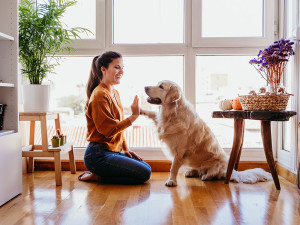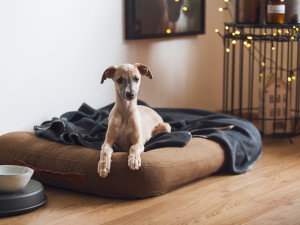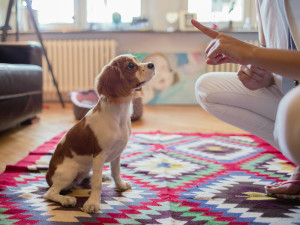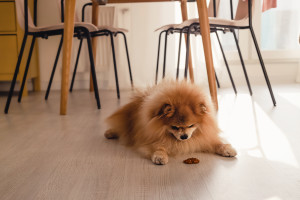How to Teach Your Dog to “Back Up”
There are plenty of benefits to teaching your dog this cute trick.
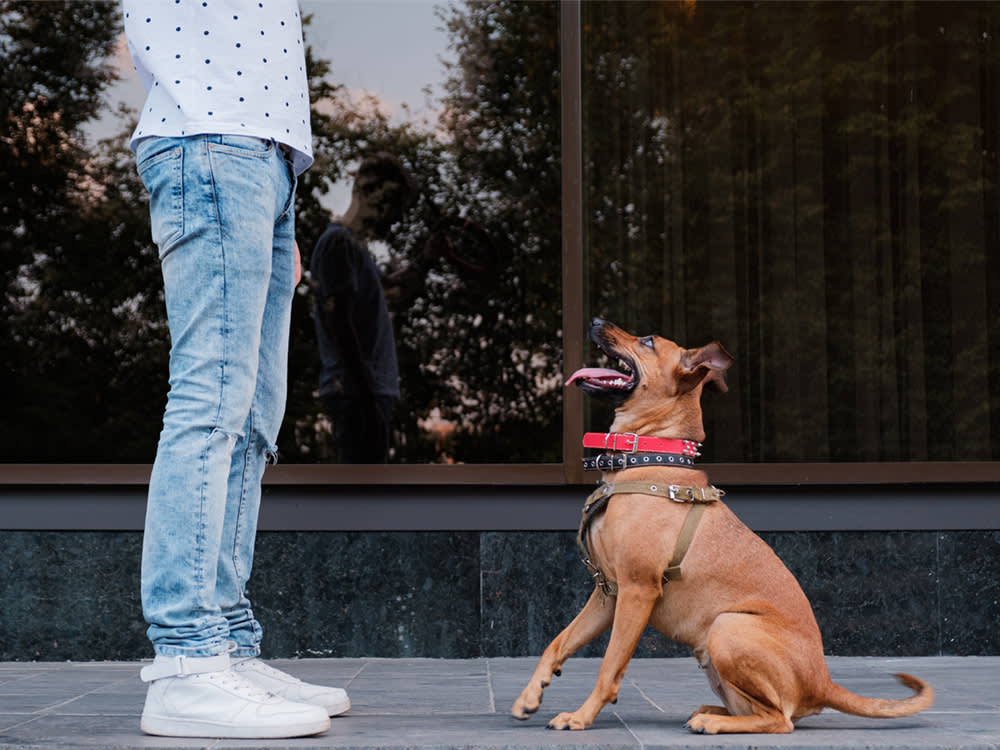
Share Article
If your dog has already mastered a slew of basic tricksopens in a new tab like crawl, spin, and rollover, and you’re looking for something new to teach your pup, look no further. Teaching your dog to back up — to move away from you by taking steps backward — is a great choice. But it’s more than just a cute party trick; teaching your pup to back away from you is actually a pretty useful trickopens in a new tab.
Even if your dog has a solid stay and wait, teaching your dog to back up will come in handy in many situations. Dogs can sometimes get in the way or literally underfoot, and asking them to “back up” solves the problem. You might be opening the front dooropens in a new tab, the pantry, or the fridge, and your dog is crowding the space. Or asking your dog to back away from a trash can, the dishwasher, another dog’s food bowl, or a toy.

littleKin™ is Kinship’s home just for puppy and kitten parents. Bop over to check out expert advice, new pet tools, and special deals—all curated for your newest family member.
opens in a new tabThe “back up” command also works while on walks to deter them from anything found on a streetopens in a new tab that looks gross or dangerous. While it’s true that the cue “leave it” will also work in those contexts — having a dog create physical distance between themselves and the forbidden object sometimes helps them resist temptation. “Leave itopens in a new tab” only tells most dogs that they may not grab something, but it gives them no help deciding what to do instead. The cue to “back up” instructs them with a specific incompatible behavior to perform. (A dog cannot simultaneously approach the dishes in the dishwasher and back away from them.)
Whether you ask them to back out of a crowded kitchen, to get out of your way as you carry a load of laundry, or to back away from an intersection with skateboarders opens in a new tabflying by — there’s no limit to how you can use this important cue.
Teach Your Dog to Back Up
In addition to its great practicality, the “back up” cue is relatively easy to teach. Here’s how:
1. Stand in front of your dog.
Start with your dog standing in front of and paying attention to you. Move toward your dog calmly.
2. Reward your dog when they step back once.
When they take a step backward, reinforce immediately with a click/treat or a treatopens in a new tab. For some dogs, a couple of steps in their direction work best but for other dogs, a slight lean is most effective.
3. Take multiple steps toward your dog.
Reinforce your dog for taking a step backward until they do it reliably. Then, move toward your dog until they have taken more than one step backward. Reward them for taking multiple steps.
4. Associate the cue “back up” to the action.
Once your pup understands that backing up is a way to earn treats, say the cue “back up” before moving toward them, and reinforce them for responding appropriately.
5. Practice, practice, practice.
With practice, you can phase out the motion toward your pup so that they are backing up in response to the cue alone. You can use a visual cue, such as extending your arm towards them instead of the verbal cue or in addition to it.
Choosing Your Verbal Cue
While I use the verbal cue “back up” for this behavior, you may use any verbal cue as long as it is consistent and easy to remember. A few common cues for this same behavior are “back out,” “get back,” and “beep beep.” Any of these words will work equally well. Choose the one you like best, but keep in mind that it’s best to avoid using a command that sounds similar to any cues your dog already knows for any other behaviors.
Common Training Hiccups
Some dogs will respond to your motion towards them by sitting down or by turning around. If your dog is a sitter during this training, try holding a treat a few inches over their head and slowly moving it towards their back end. This causes most dogs to step back rather than sit, and you can then reinforce the behavior.
If your dog’s tendency is to turn, try to train them in a narrow hallway or between two large pieces of furniture so that there’s not enough room for them to turn around. Presented with such an obstacle, most dogs will try to back up as an alternative, providing you with an opportunity to reinforce the behavior you are looking for.

Karen B. London, PhD, CAAB, CPDT-KA
Karen B. London, Ph.D., is a Certified Applied Animal Behaviorist and Certified Professional Dog Trainer who specializes in working with dogs with serious behavioral issues, including aggression, and has also trained other animals including cats, birds, snakes, and insects. She writes the animal column for the Arizona Daily Sun and is an Adjunct Professor in the Department of Biological Sciences at Northern Arizona University. She is the author of six books about training and behavior, including her most recent, Treat Everyone Like a Dog: How a Dog Trainer’s World View Can Improve Your Lifeopens in a new tab.
Related articles
![Greyhound puppy sitting on her bed on the bedroom floor]() opens in a new tab
opens in a new tabUse Platform Dog Training to Elevate Your Pup’s Skills
Using platforms are favorites with pro dog trainers—here’s why you should add them to your training to-do list.
![A red haired woman dog trainer kneeling in front of a Shepherd mixed breed dog with one finger raised that the dog is looking at in an outdoor training course.]() opens in a new tab
opens in a new tabUnderstanding Popular Dog Training Methods
Look behind the advertising language when picking a dog trainer.
![Adorable puppy focused on learning commands at home in living room]() opens in a new tab
opens in a new tabDog Training 101: What to Teach Your New Dog
In between cuddle sessions, work on these eight basic cues with your pup.
![A Pomeranian dog sitting on the floor beneath a table looking at a treat awaiting permission to eat it]() opens in a new tab
opens in a new tabA Step-by-Step Dog Training Guide for “Leave It”
This simple dog training skill could save your dog’s life.
